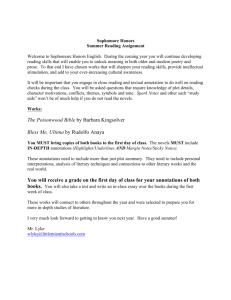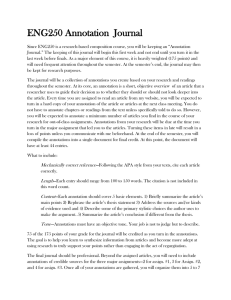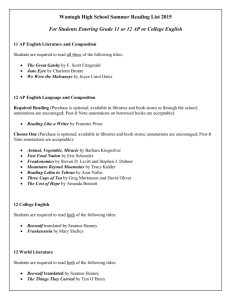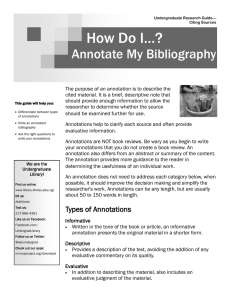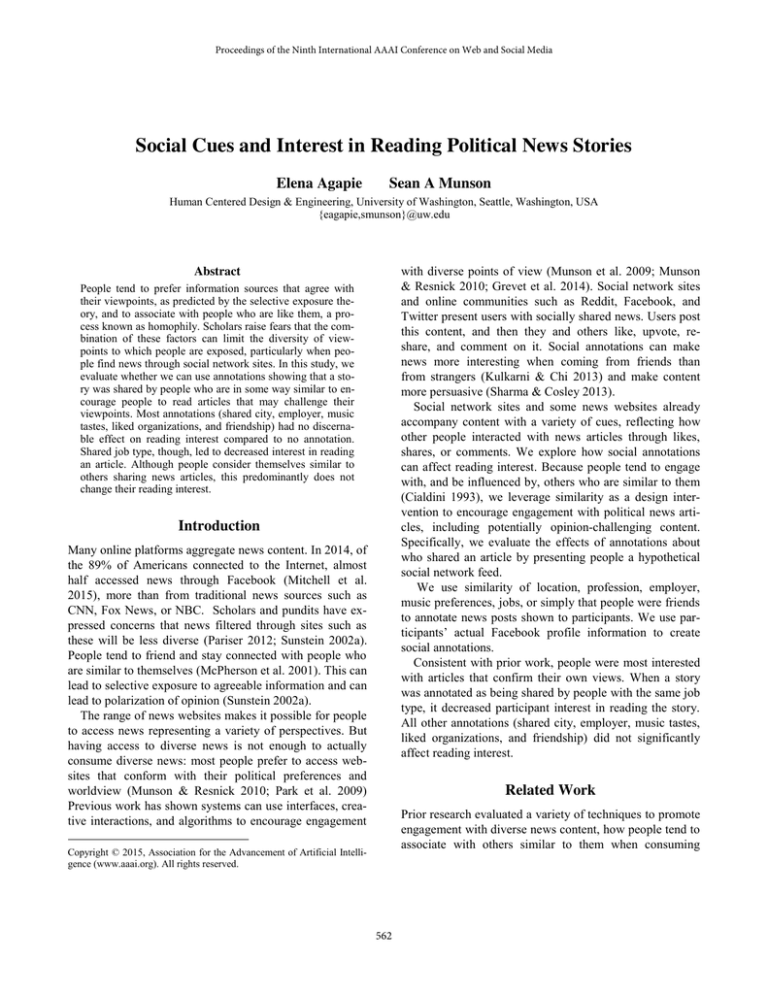
Proceedings of the Ninth International AAAI Conference on Web and Social Media
Social Cues and Interest in Reading Political News Stories
Elena Agapie
Sean A Munson
Human Centered Design & Engineering, University of Washington, Seattle, Washington, USA
{eagapie,smunson}@uw.edu
with diverse points of view (Munson et al. 2009; Munson
& Resnick 2010; Grevet et al. 2014). Social network sites
and online communities such as Reddit, Facebook, and
Twitter present users with socially shared news. Users post
this content, and then they and others like, upvote, reshare, and comment on it. Social annotations can make
news more interesting when coming from friends than
from strangers (Kulkarni & Chi 2013) and make content
more persuasive (Sharma & Cosley 2013).
Social network sites and some news websites already
accompany content with a variety of cues, reflecting how
other people interacted with news articles through likes,
shares, or comments. We explore how social annotations
can affect reading interest. Because people tend to engage
with, and be influenced by, others who are similar to them
(Cialdini 1993), we leverage similarity as a design intervention to encourage engagement with political news articles, including potentially opinion-challenging content.
Specifically, we evaluate the effects of annotations about
who shared an article by presenting people a hypothetical
social network feed.
We use similarity of location, profession, employer,
music preferences, jobs, or simply that people were friends
to annotate news posts shown to participants. We use participants’ actual Facebook profile information to create
social annotations.
Consistent with prior work, people were most interested
with articles that confirm their own views. When a story
was annotated as being shared by people with the same job
type, it decreased participant interest in reading the story.
All other annotations (shared city, employer, music tastes,
liked organizations, and friendship) did not significantly
affect reading interest.
Abstract
People tend to prefer information sources that agree with
their viewpoints, as predicted by the selective exposure theory, and to associate with people who are like them, a process known as homophily. Scholars raise fears that the combination of these factors can limit the diversity of viewpoints to which people are exposed, particularly when people find news through social network sites. In this study, we
evaluate whether we can use annotations showing that a story was shared by people who are in some way similar to encourage people to read articles that may challenge their
viewpoints. Most annotations (shared city, employer, music
tastes, liked organizations, and friendship) had no discernable effect on reading interest compared to no annotation.
Shared job type, though, led to decreased interest in reading
an article. Although people consider themselves similar to
others sharing news articles, this predominantly does not
change their reading interest.
Introduction
Many online platforms aggregate news content. In 2014, of
the 89% of Americans connected to the Internet, almost
half accessed news through Facebook (Mitchell et al.
2015), more than from traditional news sources such as
CNN, Fox News, or NBC. Scholars and pundits have expressed concerns that news filtered through sites such as
these will be less diverse (Pariser 2012; Sunstein 2002a).
People tend to friend and stay connected with people who
are similar to themselves (McPherson et al. 2001). This can
lead to selective exposure to agreeable information and can
lead to polarization of opinion (Sunstein 2002a).
The range of news websites makes it possible for people
to access news representing a variety of perspectives. But
having access to diverse news is not enough to actually
consume diverse news: most people prefer to access websites that conform with their political preferences and
worldview (Munson & Resnick 2010; Park et al. 2009)
Previous work has shown systems can use interfaces, creative interactions, and algorithms to encourage engagement
Related Work
Prior research evaluated a variety of techniques to promote
engagement with diverse news content, how people tend to
associate with others similar to them when consuming
Copyright © 2015, Association for the Advancement of Artificial Intelligence (www.aaai.org). All rights reserved.
562
news content, and how interface features affect people’s
interest in consuming content.
Exposure to diverse viewpoints and homophily. A
growing line of research studies people’s engagement with
news. People tend to engage with news that supports their
own views. This can lead to selective exposure (Sunstein
2002b). Some of these concerns relate to the potential for
social network sites to create an echo chamber effect
(McPherson et al. 2001; Goel et al. 2010). On social network sites and elsewhere, people tend to engage and associate with others like them, though they may differ politically (Goel et al. 2010; Wojcieszak& Mutz 2009). In this
study, we attempt to exploit the combination of similarity
and dissimilarity in social network sites to encourage people to read articles representing challenging views by using
annotations that highlight something the reader has in
common with people who shared the article.
Systems that encourage consuming diverse content.
Different system designs can encourage people to engage
with diverse opinions. Presentation that highlights varying
framing in articles can motivate people to consider opinions they otherwise would not read (Park et al. 2009). Living Voters Guide helped people consider and share viewpoints about proposed ballot initiatives: 45% of users who
authored any viewpoint also authored an opposing point
(Freelon et al. 2012). Expertise indicators can encourage
engagement with dissonant content (Liao & Fu 2014).
Other presentational aspects have also had an impact on
how people consume news. Balancer offers feedback on
the political lean of user news consumption, leading to a
more balanced political exposure (Munson et al. 2013).
BLEWS visually annotates articles with the leaning of who
references them (Gamon et al. 2008). Annotations of article popularity affects time spent engaging with news
(Knobloch-Westerwick et al. 2005). Social annotations are
persuasive, especially when they involve close friends recommending music content (Sharma & Cosley 2013) or
when peer names are present in an advertisement (Bakshy
et al. 2012). When social annotations, names and photos of
strangers or friends, are added to news posts, they marginally increase click rates, with friend annotations increasing
perceived interestingness of news (Kulkarni & Chi 2013).
Fig. 1. Example of article and annotation
2014). In this way, our work is similar to Hansen & Johnson’s Veiled Viral Marketing (Hansen & Johnson 2012).
We expected that, through the principle of similarity and
liking (Cialdini 1993), the annotations in our study would
increase interest in reading political news articles. Our
study included dimensions of similarity commonly present
in social network profiles, including job, employer, favorite music, support for organizations, geographic location.
We developed an experiment to evaluate the effects of
these social annotations on reading interest. We provided
participants with 12 news posts that were socially annotated. Participants were presented with one news post at a
time and asked to report their interest in reading the article
on 5-item Likert scale. After participants finished rating
the articles, they were asked to complete a survey reporting
their opinion on the topics they read about.
Procedure. The news posts were designed to resemble the
presentation of news article posts on Facebook. Each article had a title and an abstract of 30 to 45 words. The topic
of each post was one of: gun control, the Affordable Care
Act, or abortion. Topics were chosen to reflect controversial subjects about which participants would likely have a
strong opinion. We presented four articles from each topic:
two that were supportive and two that were in opposition
(except for gun control, which had 3 articles in opposition).
A journalist wrote the article abstracts to reflect strong
opinions while maintaining the tone of a news article.
As a manipulation check, we had five Mechanical Turk
workers rate the opinions reflected in each article (for example, supporting gun control or not). For the study we
only picked the article abstracts and titles on which we had
agreement from the raters. In this manipulation check, each
of the articles was presented in the interface as shared by a
person with a generic, common name: gender neutral first
names and common last names in the US. These checks
were intended to prevent effects from the name of the person sharing the article.
After participants rated their interest for each article, we
measured their opinion on the topic presented in the articles (gun control, Affordable Care Act, abortion). We used
Study Design
In this study, we evaluate whether aggregate, anonymous
annotations about a reader’s shared similarity with the
sharers can raise their interest in reading political news
articles, including viewpoint-challenging articles. Unlike
work by Kulkarni & Chi, we do not reveal names. When
people know specific friends have shared polarizing articles, they may unfriend them or hide their updates (Grevet
563
Predictors
Employer
Friends
Job
Music
None
Organization
Agreement
Article Order
Employer:Agreement
Friends:Agreement
Job:Agreement
Music:Agreement
None:Agreement
Organization:Agreement
Fig. 2. Perceived similarity between participants and people
who have the same characteristic from the intervention
survey items from Gallup and the Kaiser Foundation (Gallup 2015, Kaiser 2015).
Estimate
-0.20
-0.05
-0.63
-0.05
-0.13
-0.25
0.58
0.02
-0.11
-0.08
-0.14
0.14
0.02
0.08
Std.Err.
0.24
0.22
0.28
0.22
0.18
0.23
0.10
0.01
0.14
0.13
0.18
0.13
0.11
0.14
p
0.39
0.80
0.02
0.79
0.46
0.28
<0.01
0.08
0.45
0.51
0.43
0.28
0.83
0.56
*
***
.
n=1416, * p < .05, ** p < .01, *** p < .001
Table. 1. Ordinal regression model for reading interest
Conditions. For each news post, we randomly picked one
of seven annotations. The annotations reflected similarity
with the participant through: geographic proximity, job,
employer, music preference, cause supported, similarity as
friend or no annotation at all. Example annotations included: “Shared by people who live in [city name], [State]”,
“Shared by people who work at [organization name]”, and
“Shared by people who like [band name].” All annotations
referred to other people, but for comparison, we also had
one that referred to friends: “Shared by your friends.”
To populate the annotations, participants were required
to log into their Facebook account. We used participant
profile data to populate the annotations with data specific
to the participants. If the profile did not have an entry for
the data, no annotation was presented. If the profile had
several entries, for the music and organization (non-profit,
NGO, community) categories, we randomly picked one.
Articles were presented in randomized order, with an annotation chosen randomly. We measured participant perceived similarity to each group reflected in the annotation
using a Likert scale (e.g., “People who work at [company
name] are similar to me”).
more similar to themselves, predominantly in the city, organization, and friends conditions.
We then conducted an ordinal regression analysis evaluating the effects of the intervention on interest in reading
the articles the participants were presented with (a 5-item
Likert-like scale from -2 to 2), Table 1. Independent variables included the intervention (geographic, job, employer,
music liked, organizations liked, friends annotation). The
intercept represents the no-annotation condition. We also
included the agreement between the participant’s opinion
and the stance of the article: if the opinion of the participant on the topic is the same as the stance of the article,
then agreement is high, if it is different, then agreement is
low (5-item Likert-like scale, -2 to 2). To allow for different effects for when people agreed or disagreed with an
article’s position we include an interaction affect between
agreement and the interaction effects. Finally, anticipating
respondent fatigue, we included article order: the sequence
in which the article was presented to the participant. The
model included a random effect for each participant to account for characteristics of individual participants.
Each of the 1488 observations in the model represented
the participant’s report of article reading interest, their
agreement with the article topic, the order in which the
article was presented to the participant. In the analysis we
discarded 1 participant (12 observations) who provided the
same answer to all the questions. We discarded 60 observations from participants who had changed cities, job, or employer. Each type of annotation was presented a minimum
of 68 times (job) and maximum of 168 times (cause). For
611 article views, no annotation appeared. Consistent with
expectations, agreement has a significant positive effect on
reading interest. Participants are more interested in reading
articles that agree with their own opinion.
Of the social annotations, only job had an effect: participants were less interested in reading articles shared by oth-
Participations. We recruited through the Amazon Mechanical Turk platform and by posting about the study on
social media. We restricted Mechanical Turk participation
to those located in the US with a 98% success rate and at
least 1000 hits approved. We recruited 140 participants
(130 via Mechanical Turk and 10 via social networks). We
discarded 16 participants who did not live in the US, due to
of lack of familiarity with the article topics.
Analysis. First, we confirmed that the annotations reflected
people to whom the participant felt similar. Figure 2 shows
the distributions of perceived similarity with others sharing
similar characteristics: participants perceived others as
564
Acknowledgements
We thank Katya Yefimova for creating article abstracts.
References
Bakshy E, Dean E, Rong Y, Itamar R Social Influence in Social Advertising: Evidence from Field Experiments. EC 2012.
Cialdini R B. Influence: Science and Practice (3rd Ed.). 1993. Harper
Collins College Publishers.
Freelon DG, Kriplean T, Morgan J, Bennett WL, Borning A. Facilitating Diverse Political Engagement with the Living Voters Guide,
Journal of Information Technology & Politics 2012; 9(3).
Gallup Historical Trends. Abortion, Gun Control 2015.
Gamon M, Basu S, Belenko D, Fisher D, Hurst M, König A, BL-EWS:
Using Blogs to Provide Context for News Articles, ICWSM 2008.
Sharad G, Mason W, Watts DJ. Real and Perceived Attitude Agreement in Social Networks, Journal of Personality and Social Psychology 2010; 99(4): 611–21.
Grevet C, Loren GT, Gilbert E. Managing Political Differences in
Social Media. CSCW 2014.
Hansen DL, Johnson C. Veiled Viral Marketing: Disseminating Information on Stigmatized Illnesses via Social Networking Sites. IHI 2012.
Kaiser Family Foundation. Health Tracking Poll: Public’s Views on
the Affordable Care Act 2015.
Knobloch-Westerwick S, Sharma N, Hansen DL, Alter S. Impact of
Popularity Indications on Readers’ Selective Exposure to Online
News, Journal of Broadcasting & Electronic Media 2005.
Kulkarni C, Chi E. All the News That’s Fit to Read: A Study of Social
Annotations for News Reading, CHI 2013.
Liao Q , Fu WT. Expert Voices in Echo Chambers: Effects of Source
Expertise Indicators on Exposure to Diverse Opinions. CHI 2014.
Miller M, Smith-Lovin L, Cook JM. Birds of a Feather: Homophily
in Social Networks. Annual Review of Sociology 2001.
Mitchell A, Gottfried J, Kiley J, Matsa KE Political Polarization &
Media Habits, Pew Research Center Journalism Project 2015.
Munson SA, Lee SY, Resnick P. 2013. Encouraging Reading of
Diverse Political Viewpoints with a Browser Widget, ICWSM'13.
Munson SA, Resnick P. Presenting Diverse Political Opinions: How
and How Much, CHI 2010.
Munson SA, Zhou DX, Resnick P. Sidelines: An Algorithm for Increasing Diversity in News and Opinion Aggregators. ICWSM 2009.
Pariser E. The Filter Bubble: How the New Personalized Web Is
Changing What We Read and How We Think. Penguin Books. 2012.
Park S, Seungwoo K, Sangyoung C, Junehwa S. NewsCube: Delivering Multiple Aspects of News to Mitigate Media Bias, CHI 2009.
Sharma A, Cosley D Do Social Explanations Work?: Studying and
Modeling the Effects of Social Explanations in Recommender Systems. WWW 2013.
Sunstein CR. Republic.Com, Princeton University Press. 2002a.
Sunstein CR The Law of Group Polarization. Journal of Political
Philosophy 2002b; 10(2): 175–95.
Wojcieszak ME, Mutz DC. Online Groups and Political Discourse:
Do Online Discussion Spaces Facilitate Exposure to Political Disagreement? Journal of Communication 2009; 59(1): 40–56.
Fig. 3. Reading interest according to intervention and participant
agreement with the article presented
ers with the same job. All other annotations did not affect
interest, compared to no annotation. We also observed no
significant interaction effects. Figure 3 illustrates participant interest in reading articles across the different interventions according to their agreement with the articles.
Discussion
While Kulkarni & Chi demonstrated that annotations
related to friends increase click through rates, we found
that a generic annotation referring to friends did not increase reading interest. This confirms previous work which
emphasized that names of friends are more influential as
annotations (Bakshy et al. 2012 Sharma & Cosley 2013).
Despite participants generally perceiving the groups
indicated in the annotations as similar to themselves, only a
shared job had an effect on reading interest. Unexpectedly,
it decreased reading interest. Further analysis is needed to
understand this result. One possibility is that it is specific
to the Mechanical Turk participants, who may identify
with their jobs less than others. Our study may also have
been limited by demand effects or reactivity, in which participants figured out the intent of the study. Future work in
the field may help resolve this issue. Finally, our study
evaluated the effects of annotations on articles about controversial political news topics, and participants may react
differently to annotations on less controversial issues or
non-political topics.
Conclusion
Previous work has shown that social annotations are useful
for establishing trustworthiness and persuasiveness of content, especially when reflecting friend relationships. In this
study, we find that while readers feel similar to people indicated in social annotations not containing name, these
annotations largely did not affect their interest in reading
political news articles shared on social network sites. In the
case of an annotation indicating a shared job, it actually
decreased participant interest. Further research is needed to
understand best practices for the design of social annotations and their limitations.
565

